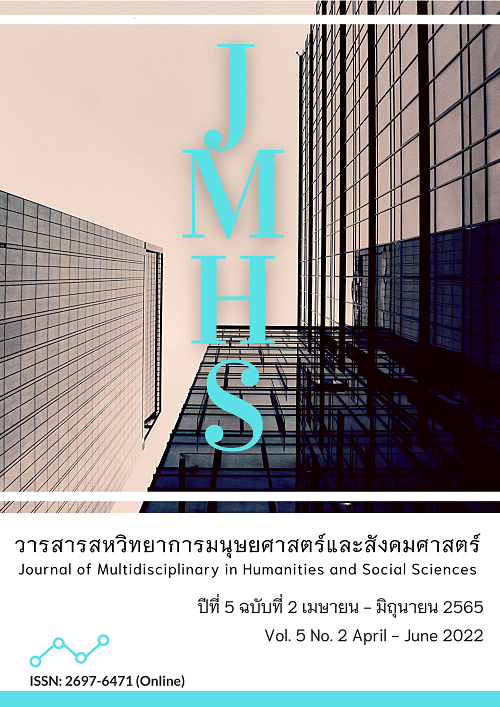The Development of Creative Thinking with Mathematics Learning based on STEAM Education for 8th Grade Students
Main Article Content
Abstract
This article aimed to 1) develop creative thinking with mathematics learning STEAM education for 8th grade students; 2) compare students’ achievement before and after learning; and 3) study students' satisfaction with mathematics learning STEAM education. This study was experimental research. STEAM Education was used as the main research framework. The research was conducted at Kasetsart University Laboratory School, Kamphaeng Saen Campus Educational, Nakhon Pathom. The sample consisted of students in Mathayom 2/1, semester 1 of the academic year 2021. They were selected by cluster random sampling. The instruments for collecting data were 1) a mathematics learning management plan based on the concept of STEAM education, 2) learning achievement tests, 3) creative assessment forms, and 4) a questionnaire to investigate satisfaction. Analysis of data by mean, standard deviation, dependent sample t-test, and intraclass correlation coefficient (ICC). The research results were found as follows: 1. The student’s creative thinking after learning through STEAM education is at a very good level; 2. The students’ achievements through STEAM education after learning were significantly higher than those before studying at the .05 level; and 3. The student’s satisfaction with mathematics learning in STEAM education was positive at a good level.
Article Details

This work is licensed under a Creative Commons Attribution-NonCommercial-NoDerivatives 4.0 International License.
Views and opinions appearing in the Journal it is the responsibility of the author of the article, and does not constitute the view and responsibility of the editorial team.
References
ชนิตา ปานรอด, พินดา วราสุนันท์ และ สุนทราภรณ์ อุ่นวรรณธรรม. (2563). การพัฒนาผลฤทธิ์ทางการเรียนคณิตศาสตร์ เรื่อง อัตราส่วน สัดส่วน และร้อยละ โดยใช้การจัดการเรียนรู้ตามแนวคิดสะตีมศึกษาของนักเรียนชั้นมัธยมศึกษา ปีที่ 1. วารสารศาสตร์การศึกษาและการพัฒนามนุษย์, 4(1), 28-43.
ดารุณี เพ็งน้อย และ นิวัฒน์ บุญสม. (2564). การพัฒนาความสามารถในการแก้ปัญหาอย่างสร้างสรรค์และการ สร้างผลงานทางวิทยาศาสตร์ ของนักเรียนชั้นประถมศึกษา ปีที่ 5 ด้วยการจัดกิจกรรมการเรียนรู้ตามแนวคิด STEAM Education. วารสารศิลปากรศึกษาศาสตร์วิจัย, 13(1), 238-257.
ฟัตมาอัสไวนี ตาเย๊ะ, ณัฐินี โมพันธุ์ และ มัฮดี แวดราแม. (2560). ผลของการจัดการเรียนรู้ตามแนวคิดสะตีมศึกษาที่มีผลต่อผลสัมฤทธิ์ทางการเรียนวิทยาศาสตร์ ความคิดสร้างสรรค์ และความพึงพอใจต่อการจัดการเรียนรู้ของนักเรียนชั้นประถมศึกษา ปีที่ 5. วารสารมหาวิทยาลัยนราธิวาสราชนครินทร์ สาขามนุษยศาสตร์และสังคมศาสตร์, 4(2), 1-14.
ภิญโญ วงษ์ทอง. (2561). ผลของการจัดกิจกรรมการเรียนรู้บูรณาการ STEAM Education ที่มีต่อผลสัมฤทธิ์ทางการเรียนวิทยาศาสตร์ทักษะการคิดอย่างมีวิจารณญาณ และความพึงพอใจของนักเรียนชั้นประถมศึกษา ปีที่ 4. วารสารหน่วยวิจัยวิทยาศาสตร์ เทคโนโลยี และสิ่งแวดล้อมเพื่อการเรียนรู้, 10(1), 94-112.
ภิญโญ วงษ์ทอง, สมเสมอ ทักษิณ และ ทัศนัย สูงใหญ่. (2563). การพัฒนาความสามารถในการคิดสร้างสรรค์ด้วยการจัดการเรียนรู้บูรณาการสตีมศึกษาสำหรับนักเรียนชั้นประถมศึกษา ปีที่ 1 ในโรงเรียนประถมศึกษาขนาดเล็ก. วารสารศึกษาศาสตร์ มหาวิทยาลัยมหาสารคาม, 14(3), 151-169.
สมรัก อินทวิมลศรี. (2560). ผลของการใช้แนวคิดสะตีมศึกษาในวิชาชีววิทยาที่มีต่อความคิดสร้างสรรค์ทางวิทยาศาสตร์และผลสัมฤทธิ์ทางการเรียนของนักเรียนชั้นมัธยมศึกษา ปีที่ 4. วารสารครุศาสตร์ จุฬาลงกรณ์มหาวิทยาลัย, 47(2), 410-429.
สุภัค โอฬาพิริยกุล. (2561). STEAM EDUCATION: นวัตกรรมการศึกษาบูรณาการสู่การจัดการเรียนรู้. วารสารวิจัยและพัฒนาหลักสูตร, 9(1), 1-16.
สุมินตรา จีนเมือง และ ธิติยา บงกชเพชร. (2563).การจัดการเรียนรู้ตามแนวคิดสะเต็มศึกษาด้วยกระบวนการออกแบบเชิงวิศวกรรม เรื่อง เสียงเพื่อส่งเสริมความคิดสร้างสรรค์และนวัตกรรม สำหรับนักเรียนชั้นมัธยมศึกษาปีที่ 5. วารสารศึกษาศาสตร์ มหาวิทยาลัยบูรพา, 31(1), 59-74.
อารี พันธ์มณี. (2557). ฝึกให้คิดเป็นคิดอย่างสร้างสรรค์. กรุงเทพฯ: จุฬาลงกรณ์มหาวิทยาลัย.
เอกสิทธิ์ ชนินทรภูมิ, มาเรียม นิลพันธุ์, อนิรุทธ์ สติมั่น และ วิสูตร โพธิ์เงิน. (2564). การพัฒนารูปแบบการเรียนการสอนตามแนวคิด STEAM เพื่อส่งเสริมทักษะการสร้างสรรค์นวัตกรรมทางเทคโนโลยีของนักเรียนชั้นมัธยมศึกษา. วารสารวิจัยและพัฒนาหลักสูตร, 11(1), 22-35.
Aksorn Learnspace. (2017). จาก STEM สู่ STEAM กับแผนปั้นผู้เรียนคุณภาพ. Retrieved January 24, 2021, from https://www.aksorn.com/stem.
All Education Schools. (n.d). Resources for Current & Future STEAM Educators. Retrieved February 6, 2021, from https://www.alleducationschools.com/resources/steam-education.
Shriki, A. (2010). Working like real mathematicians: developing prospective teachers’ awareness of mathematical creativity through generating new concepts. Educational Studies in Mathematics, 73, 159-179.
Yakman, G. (2008). STEAM Education: an overview of creating a model of integrative education. Retrieved February 4, 2021, from https://www.researchgate.net/publication/327351326_STEAM_Education_an_overview_of_creating_a_model_of_integrative_edu cation.
Yakman, G. (2010). What is the Point of STEAM? A Brief Overview. Retrieved February 6, 2021, from www.steamedu.com.


